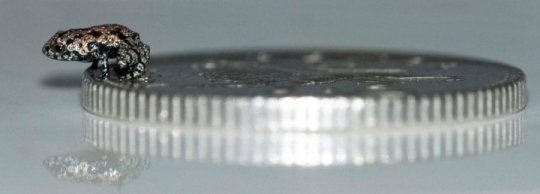[ad_1]
Research scientists led by the University of Kent have uncovered hidden diversity within a type of frog found only in the Seychelles, showing that those on each island have their own distinct lineage.
The family tree of sooglossid frogs dates back at least 63 million years. They are living ancestors of those frogs that survived the meteor strike on earth approximately 66 million years ago, and their most recent common ancestor dates back some 63 million years, making them a highly evolutionarily distinct group.
However, recent work on their genetics led by Dr Jim Labisko from Kent’s School of Anthropology and Conversation revealed that until they can complete further investigations into their evolutionary relationships and verify the degree of differentiation between each island population, each island lineage needs to be considered as a potential new species, known as an Evolutionarily Significant Unit (ESU). As a result, Dr Labisko advises conservation managers they should do likewise and consider each as an ESU.
There are just four species of sooglossid frog; the Seychelles frog (Sooglossus sechellensis), Thomasset’s rock frog (So. thomasseti), Gardiner’s Seychelles frog (Sechellophryne gardineri) and the Seychelles palm frog (Se. pipilodryas).
Of the currently recognised sooglossid species, two (So. thomasseti and Se. pipilodryas) have been assessed as Critically Endangered, and two (So. sechellensis and Se. gardineri) as Endangered for the International Union for Conservation of Nature IUCN Red List. All four species are in the top 50 of ZSL’s (Zoological Society of London) Evolutionarily Distinct Globally Endangered (EDGE) amphibians.
Given the Red List and EDGE status of these unique frogs Dr Labisko and his colleagues are carrying out intensive monitoring to assess the level of risk from both climate change and disease to the endemic amphibians of the Seychelles.
Dr Labisko, who completed his PhD on sooglossid frogs at Kent’s Durrell Institute of Conservation and Ecology in 2016 said many of these frogs are so small and good at hiding the only way to observe them is by listening for their calls. Although tiny, the sound they emit can be around 100 decibels, equivalent to the sound volume of a power lawnmower’.
Dr Labisko’s team are using sound monitors to record the vocal activity of sooglossid frogs for five minutes every hour, every day of the year, in combination with dataloggers that are sampling temperature and moisture conditions on an hourly basis
Dr Labisko said: ‘Amphibians play a vital role in the ecosystem as predators, munching on invertebrates like mites and mosquitos, so they contribute to keeping diseases like malaria and dengue in check. Losing them will have serious implications for human health.’
As a result of this study into the frogs, the research team will also contribute to regional investigations into climate change, making a local impact in the Seychelles.
Amphibians around the world are threatened by a lethal fungus known as chytrid. The monitoring of these sooglossid frogs will provide crucial data on amphibian behaviour in relation to climate and disease. If frogs are suddenly not heard in an area where they were previously, this could indicate a range-shift in response to warming temperatures, or the arrival of disease such as chytrid — the Seychelles is one of only two global regions of amphibian diversity where the disease is yet to be detected.
It may also impact on a variety of other endemic Seychelles flora and fauna, including the caecilians, a legless burrowing amphibian that is even more difficult to study than the elusive sooglossids.
Researchers know that caecilians can be found in similar habitats to the frogs, so they can use the frog activity and environmental data they are collecting to infer caecilian presence or absence and generate appropriate conservation strategies as a result.
Endemic, endangered and evolutionarily significant: cryptic lineages in Seychelles’ frogs (Anura: Sooglossidae) by Jim Labisko Richard A Griffiths Lindsay Chong-Seng Nancy Bunbury Simon T Maddock Kay S Bradfield Michelle L Taylor Jim J Groombridge is published in the Biological Journal of the Linnean Society.
Story Source:
Materials provided by University of Kent. Note: Content may be edited for style and length.
[ad_2]















